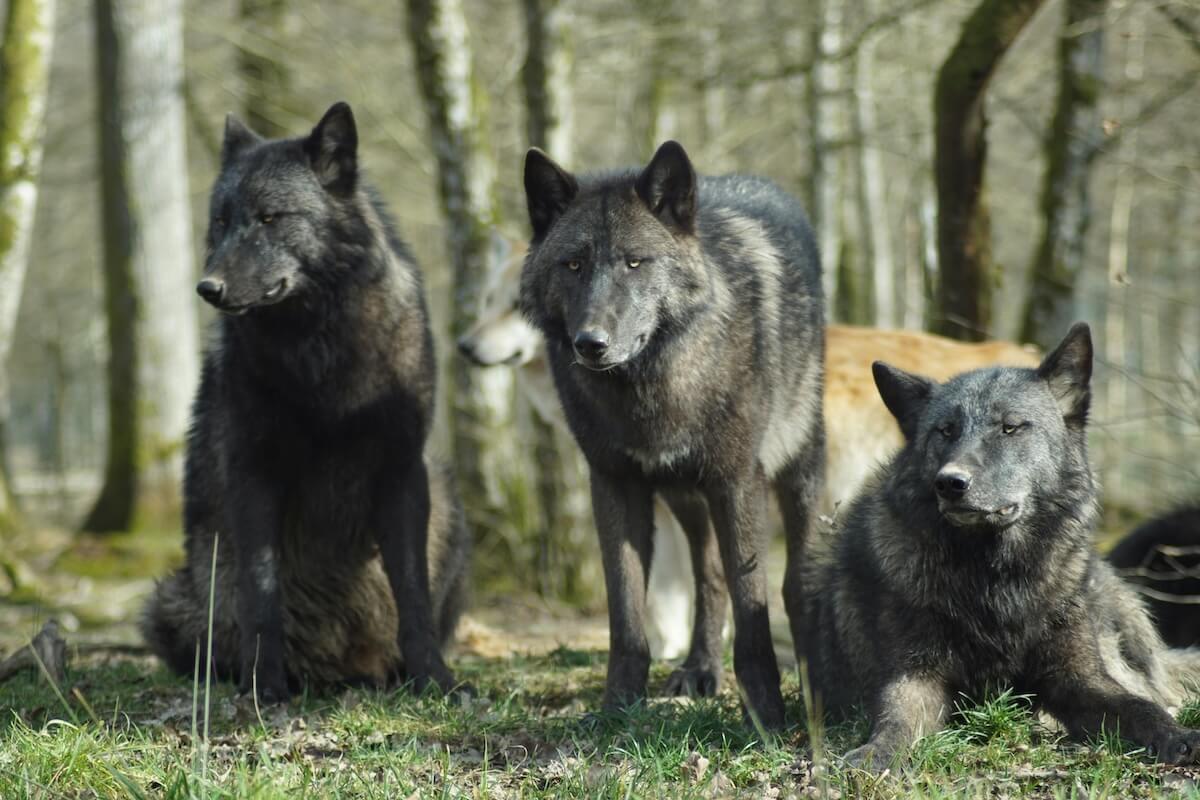The Company of Wolves (1984) was mismarketed.
A British production, curiously, the infamous moviemaking wildcard Cannon films (Bloodsport, Death Wish 3) distributed it in the United States, and they branded the film a horror show.
You can see why. Check out the lurid image of a wolf crawling from a throat on this film poster or the nudity and blood on this more provocative version.
But scares are part of the film’s means, not its ends.
Like a somewhat surrealist nightmare, it explores the erotic teenage undertones of Little Red Riding Hood.
So while there are many things you can blame Cannon films for (like Sly Stallone’s arm wrestling movie, Over the Top), this low-budget entry wasn’t straightforward to pitch to the public.
Fantasy had its moments in the 1980s. There were films like The Princess Bride, Conan the Barbarian, Highlander, and many more.
But The Company of Wolves is a gothic fairy tale for adults released before Tim Burton came along and made that sort of thing cool.
The film did ~ break-even business, and only thanks to the time capsule that is the internet did I hear the howling of Wolves as some audiences’ forgotten gem.
And I was drawn in further thanks to outrageous screencaps like this. Prosthetic wolf-headed people dining with the elite certainly tease my fancy.
The film is adapted from heralded British magical-realism author Angela Carter’s short story of the same name, and the movie kept that tone.
And the picture is directed by Neil Jordan, who has a solid track record in alluring fantasy literature adaptations (Interview with a Vampire).
The film received four BAFTA nominations (costume design, special visual effects, best makeup and hair, and best production design).
But there’s more to a film than biting imagery.
So is The Company of Wolves a good movie?
The Plot of The Company of Wolves:
A young girl dreams that she is Rosaleen (Sarah Patterson), a peasant living with Mother (Tusse Silberg) and Father (David Warner) in a small 18th-century English village.
After her sister, Alice (Georgia Slowe), is killed by wolves, Rosaleen develops a fear and fascination for the creatures, which prey on the town at night.
Meanwhile, as neighbor Amorous Boy (Shane Johnstone) courts her, Rosaleen becomes curious about love and attraction.
And she listens to stories spun by Granny (Angela Lansbury) that warn about the desires of wolves and men.
The Rest of the Main Cast Includes:
- Micha Bergese as Huntsman
- Brian Glover as Amorous Boy’s father
- Graham Crowden as Old Priest
- Kathryn Pogson as Young Bride
- Stephen Rea as Young Groom
- Susan Porrett as Amorous Boy’s mother
- Dawn Archibald as Witch Woman
- Richard Morant as Wealthy Groom
- Danielle Dax as Wolfgirl
- Jim Carter as Second Husband
- Terence Stamp as The Devil
The Good Things:
Surreal Images and Symbolism, + 2 Points
As the film is an adolescent’s dream, it plays like one. Yet all of its surrealism is for the sake of artistry, never overindulgent or odd just for the sake of it.
Moments that could be gory realities shift into dream pieces. A head is lopped off and shatters like a clay pot instead of a stringy pile of blood things.
Events can be unrealistic, creating a compelling mystery in the film. When Rosaleen climbs a tree and finds blue bird’s eggs, they begin to hatch. Yet where we’d expect a hungry chick to emerge, there are human dolls.
The cinematography creates captivating compositions, like when a delicate white bird rests in the foreground and could-be young lovers stand in the background.
And there’s a visual motif with white and red – perhaps innocence lost.
In close-up, a white flower blooms until red blood drips upon it, slowly dying it crimson. A wolf eats in the snow, drops of blood falling over the dove-white ice.
The playfulness of the symbols and the blocking of the actors creates erotic undertones. We visually understand this is a young girl coming of age, warned about the beastliness of men and her attraction to the werewolf’s seduction.
Mighty Morphin Power Wolves, +2 Points
I’m not a gorehound. Still, the grotesque werewolf transformations are deliciously horrifying. The film could fail without the disgusting human-to-beast sequences of the wolves who are “hairy on the inside.”
While things don’t reach The Thing levels of sickening nasty, there’s enough here to kick your young kids out of your home theater.
The brilliance is in the imaginative direction they unfold. Werewolf films like Teen Wolf or An American Werewolf in London have excellent transition scenes that run with a time-lapse of the appendages — the expanding feet, the slow-growing hair, and the extension of claws.
Here, things get a different form of down and dirty. These transformations are more like the shedding of a disguise. The masquerade ends when a wolf living beneath human flesh emerges instead of a human turning into a wolf.
The first transformation is a horrifying flesh ripping to reveal the wolf beneath, all red sinews and bloodied.
In the second, as in the poster, a wolf painfully slips straight from its human-form mouth.
Yet with all the terror-inducing visuals, you feel sympathy for the werewolves in much pain. The audience’s compassion for the werewolves helps us understand Rosaleen’s fascination and pity for them.
Tales Within the Tale, +3 Points
The film has an unorthodox structure. Rosaleen, our stand-in for Little Red Riding Hood, only makes her fabled journey to Grandma’s in the third and final act (and don’t be mad at me for spoiling that — you know it’s going here).
The rest of the narrative follows her day-to-day.
Then multiple tales, also written by Angela Carter, fill in the themes. Moralistic stories and warnings, these dark anecdotes of Granny’s fill out the cultural values thrust on young Rosaleen.
There’s a story about a woman who unknowingly married a werewolf; a boy who makes a bargain with the Devil; a pregnant, bitter sorceress who crashes a wedding party; and my favorite: a delicate, young wolf girl who ventures into a village.
These aren’t detours; so the film doesn’t meander. It builds Rosaleen’s character toward the inevitable confrontation with the werewolf.
Even though the tales work, this structure most likely came from necessity. Carter’s original short story wasn’t long enough for a feature-length. Still, these additional tales sew themes together while standing alone as darkly gripping.
Performances, +2 Points
Angela Landsbury, as Granny, brings needed levity. Ms. Murder, She Wrote trades in her typewriter for sewing needles. The old curmudgeon tells Rosaleen nightmarish stories before bed and demands a kiss on the cheek as a reward.
But of all Granny’s little wisdoms, her best is to never trust a man whose eyebrows meet in the middle (the sign of a werewolf).
Micha Bergese, in his first feature film role, plays it hungry like the wolf with aplomb. A gaunt dancer with streaks of hair, he’s an easy physical match. But his rakish, smooth turn as the confident, forward Huntsman delights.
And young Sarah Patterson, also in her first role, is our wide-eyed belle of innocence. At just ~13, the actress may have been too young to understand some of the film’s themes. But her subtle performance depicts the quiet contemplation of a bubbling mind.
Patterson was reportedly denied admission at the London Premiere because she was under 18 – too young for the movie’s rating. Hopefully, an explanation solved this.
And an honorable mention here to Stephen Rea as the werewolf of Granny’s fable. Note his bent, creaturelike posture on his return to his wife, leaning into the anger of a jealous wolfsband (wolf husband).
Dark Forest Village, +4 Points
The film’s award-nominated production values set the fairy-tale tone. It depicts peasant life as nasty, brutish, and short, all right; but somewhere lurks hints of hopeful magic.
A low-budget at work, director Neil Jordan described the film’s whole forest as about 12 trees on rollers. Yet somehow, they’ve created a magic land.
Everything looks grimy and worn. Tarantulas fall from the ceiling. Light barely touches the dreary village. And yet occasional rainbows of brilliant color run through it, oversized mushrooms dotting the foreground.
The costumes look cumbersome. Cotton corsets and gowns are tied by strings, each outfit representing the heft and weight of a hand-sewn era. None is more brilliant than Rosaleen’s essential scarlet cloak. The houses are complete with family stewpots and antique dishware of people who scrape by long winters.
The Not-As-Good Things:
That’s Not Your Wolf, it’s a Dog, Baby! -0 Points
The film gets by generally doubling dogs as wolves. But in the final shots, as “wolves” tear down a hallway in close-up – yeah, you lose the illusion.
I won’t remove points for it. It’s not like this low-budget 1980s production had access to CG, nor would a pack of actual wolves conceivably be safe for cast and crew (and possibly an animal rights issue).
Still, the film loses some luster when it’s just good old canis lupus familiaris crashing through your window.
Go Watch The Company of Wolves
Total Arbitrary Points Score: 13 Points
The Company of Wolves is a just-right fantasy for fans of provocative filmmaking. Visually brilliant, even if at times horrific, it is a darkly magic story of a young girl’s journey to womanhood and the desires of men.
Far more than a grown-up Little Red Riding Hood, the award-nominated production excels at transporting you to a mysterious atmosphere, a peaceful village haunted by the threat of sinister packs of large-bred wolves.
With spot-on performances and an unconventional structure, the film is perfect for fans of atmospheric movies.
I’ve long considered unibrows a threat to humanity. And now, Thanks to The Company of Wolves, I have proof.
Enjoyed this Post?
Thank you so much. If you’d like to get a ping when I have a new article, you can join my newsletter below.
Disclaimer:
This review’s factual information was gathered through online sources, like Wikipedia, IMDB, or interviews. Misrepresentations and errors are possible but unintentional.
Making art is hard. This is a fan’s blog. Any criticisms are meant to be constructive.




